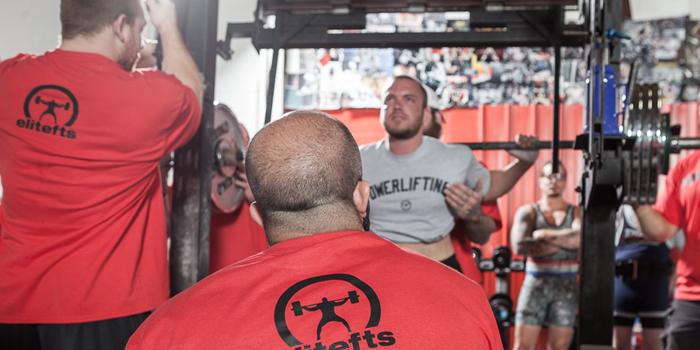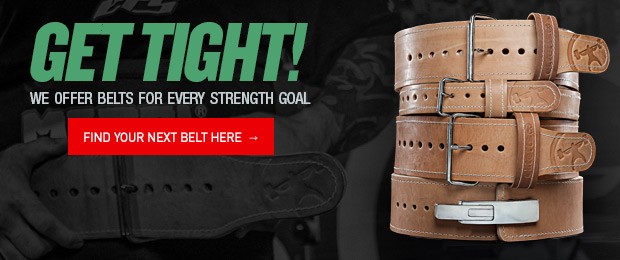
Originally published in September of 2003
After being part of the Force Training Seminars for almost two years, Dave Tate and I have seen a wide variety of squat technique. Some of these techniques, and I am being polite here, are intriguing and always have us scratching our heads. There are several technical faults that are common to every seminar. Below is a list of these faults. If you cannot attend a seminar, I highly suggest that you purchase the Westside Seminar Videos, the Squat Workout Video or the Reactive Method Video (go to www.westside-barbell.com to purchase these videos). All three of these show proper squat form. After viewing these tapes, film yourself squatting and compare. You will quickly see what needs to be changed and what you are doing correctly. It wasn’t until I received the Squat Workout Video, more than three years ago, that I realized I was going about it the wrong way. Do yourself a favor and focus on technique; don’t get too wrapped up in band tension, percents, etc. Get your technique down and worry about the other things later. Developing bad squat form is easy. Correcting years of poor technique is one of the hardest things to do. That is why novices are so easy to teach; we don’t have to correct years of motor learning.
1. Stance is too close.
It is always a shock to people at the seminar to see how wide of a stance Dave and I take when doing our dynamic squats. Remember that the stance that we use during meets is closer than the one we use in training. Still the wide stance does wonders in building up your hip strength. If you think you need to move your stance out, I suggest that you start slowly by moving your feet out an inch on both sides. Also, in order to keep from straining your hips, you may have to use a slightly higher box during your warm-ups to ensure that your hips are warmed up. Wearing groove briefs or a squat suit will also help keep your hips healthy. Performing some kind of stretching, whether it be dynamic or static, can also help you box squat with a wide stance.
Bottom line: Most people do not take a wide enough stance on dynamic day. Do yourself and your squat a favor and use a wide stance. Not only will your hips become stronger but your squat will take off.
2. Flexing off of the box with the quads, not the hips.
The easiest way to remedy this problem is by pushing your knees out and keeping the pressure on the sides of your shoes. You should not be on your heels or toes. By pushing your knees out (spreading the floor) you are ensuring a shorter bar path and thus a more efficient squat. Picture yourself on a Smith Machine (please, no comments); this is how straight of a bar path that you want. If you are not wearing a flat-soled shoe, then the spreading the floor will be close to impossible.
3. Not pushing out with your abs.
This is not a technique that is used just for those with a thick waist. If this was the case then Chuck Vogelpohl, who is as lean as they come, could not do this. The trick is to push out with your obliques and push out on the sides of your belt. If you want to practice this, have someone put their fingers on the sides of your abs. Try some bodyweight box squats and practice pushing out on their fingers. Do not allow them to “puncture” your abs. This is the sensation that you want. Also, when you take a breath to fill your stomach, your shoulders should not rise. If they do, then you do not know how to breathe when you squat. Your stomach should expand; your shoulders should not rise.
4. Not keeping your arch.
This is one of the keys to a big squat. Being able to hold a tight arch is essential in maintaining the proper position while squatting. This is a very uncomfortable position and it should be noted that squatting is not a comfortable exercise.
5. Weak posterior chain.
This is something we all fall victim to. How strong is strong enough? I’ll let you know when I figure it out. Simply put, never stop training your low back, hamstrings, glutes, lats and upper back. Hit your posterior chain with a wide variety of effective exercises such as glute ham raises, Reverse Hyper™, back raises, pull throughs, Romanian deadlifts, Dimel deadlifts, good mornings (of all varieties), various lat and upper back exercises, sled dragging (of all varieties) and any other exercises that you think can build your squat.
6. Learning how to sit back and down.
Your squat form on a box should mirror your free squat form. While many people have a tough time sitting back during a squat we have also seen many times people sit back too far on a box. This does not translate into a meet squat. These people need to learn to sit back and down.
7. Keeping the elbows tucked.
When lifters keep their elbows tucked, or at least attempt to keep them tucked, they will virtually eliminate the tendency to fall forward during a squat. By keeping the elbows tucked underneath the bar (or close to it) then they will also keep the bar in the correct path and ensure that their hips will be under them when they squat. When I see a lifter’s elbows flared out and back, they will undoubtedly fall forward. Their butts will also come up first and thus lose hip power and place unneeded stress on their low backs. Believe me, this is what happened to me at my last meet.










1 Comment